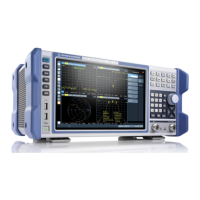VNA GUI reference
R&S
®
ZNL/ZNLE
420User Manual 1178.5966.02 ─ 20
Tip (alternative formats): It is possible to view the magnitude and phase of a complex
quantity instead of the real and imaginary part. The magnitude can be displayed on a
linear scale or on a logarithmic scale. Both the real and imaginary parts are displayed
in the polar diagram.
Remote command:
CALCulate<Chn>:FORMat IMAGinary
Inv Smith
Selects an inverted Smith chart to display a complex quantity, primarily a reflection S-
parameter.
Properties: The inverted Smith chart is a circular diagram obtained by mapping the
positive complex semi-plane into a unit circle. If the measured quantity is a complex
reflection coefficient S
ii
, then the unit inverted Smith chart represents the normalized
admittance. In contrast to the polar diagram, the scaling of the diagram is not linear.
Application: Reflection measurements, see example in "Inv Smith" on page 213.
Tip: The axis for the sweep variable is lost in Smith charts but the marker functions
easily provide the stimulus value of any measurement point. dB values for the magni-
tude and other conversions can be obtained by the "Marker Format" functions.
Remote command:
CALCulate<Chn>:FORMat ISMith
Delay
Calculates the (group) delay from the measured quantity (typically a transmission S-
parameter) and displays it in a Cartesian diagram.
Properties: The group delay τ
g
represents the propagation time of wave through a
device. τ
g
is a real quantity and is calculated as the negative of the derivative of its
phase response. A non-dispersive DUT shows a linear phase response, which produ-
ces a constant delay (a constant ratio of phase difference to frequency difference).
For more information, refer to Chapter 9.3.8, "Group delay", on page 229.
Application: Transmission measurements, especially with the purpose of investigating
deviations from linear phase response and phase distortions. To obtain the delay, a fre-
quency sweep must be active.
Tip: The cables between the analyzer test ports and the DUT introduce an unwanted
delay, which often can be assumed to be constant. Use the Zero Delay at Marker func-
tion, define a numeric length "Offset" or use the "Auto Length" function to compensate
for this effect in the measurement results. To compensate for a frequency-dependent
delay in the test setup, a system error correction is required.
Note: The delay for reflection factors corresponds to the transmission time in forward
and reverse direction; see "Length and delay measurement, related settings"
on page 279.
Remote command:
CALCulate<Chn>:FORMat GDELay
Aperture Points
Defines an aperture Δf for the (group) "Delay" calculation. The value is entered as
number of sweep steps (= number of sweep points - 1).
Format softtool

